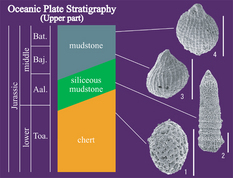Bulletin of the Geological Survey of Japan Top Page
Bulletin of the Geological Survey of Japan Vol.55 No.9/10 (2004)
Cover photograph | Table of Contents | Abstract
Cover photograph

Upper part of the oceanic plate stratigraphy of the Jurassic accretionary complex (an example).
Oceanic plate stratigraphy shows a travel history of an oceanic plate from mid oceanic ridge to trench. Although the initial stratigraphy of the sediments on the oceanic plate is lost by deformation during the accretionary process, the stratigraphy consisting of basalt, limestone, chert, siliceous mudstone, and mudstone and sandstone in ascending order can be reconstructed. Radiolarians play an important role in the age determination of each rock type. To reconstruct the oceanic plate stratigraphy is important in examination of tectonic history and in broad correlation. All following radiolarians were obtained from the Chichibu Belt in the Toyohashi area; 1: Archicapsa pachyderma (Tan), 2: Laxtorum jurassicum Isozaki et Matsuda, 3: Tricolocapsa plicarum Yao, and 4: Tricolocapsa conexa Matsuoka. All scale bars indicate 100 μm.
(Nobuharu Hori)
Table of Contents
| Title | Author | |
|---|---|---|
| Article | ||
| Oceanic plate stratigraphy of the accretionary complex of the Chichibu Belt in the Toyohashi district, Aichi Prefecture, Southwest Japan. | Nobuharu Hori (271-285) | 55_09_01.pdf [544 KB] |
| Notes and Comments | ||
| Permian radiolarians from chert of the Chichibu Belt in the Toyohashi district, Aichi Prefecture, Southwest Japan. | Nobuharu Hori (287-301) | 55_09_02.pdf [1,696 KB] |
| Triassic radiolarians from chert of the Chichibu Belt in the Toyohashi district, Aichi Prefecture, Southwest Japan. | Nobuharu Hori (303-334) | 55_09_03.pdf [2,829 KB] |
| Jurassic radiolarians from chert and clastic rocks of the Chichibu Belt in the Toyohashi district, Aichi Prefecture, Southwest Japan. | Nobuharu Hori (335-388) | 55_09_04.pdf [5,832 KB] |
Abstract
Oceanic plate stratigraphy of the accretionary complex of the Chichibu Belt in the Toyohashi district, Aichi Prefecture, Southwest Japan.
Nobuharu Hori
Accretionary complex of the Chichibu Belt in the Toyohashi district, Aichi Prefecture, Southwest Japan is tectonostratigraphically divided into Unit A, B and C by Niwa and Otsuka (2001). Based on the radiolarian biostratigraphy, the oceanic plate stratigraphy (OPS) of Unit A and Unit B (Niwa and Otsuka, 2001) is reconstructed. The OPS of Unit A is composed of Lower Permian to upper Middle Jurassic chert, upper Middle Jurassic siliceous mudstone and upper Middle to lower Upper Jurassic mudstone, in ascending order. The OPS of Unit B consists of Lower Permian to lower Middle Jurassic chert, upper Lower to upper Middle Jurassic siliceous mudstone and middle Lower to lower Upper Jurassic mudstone, in ascending order. The duration of the deposition of mudstone of Unit B is much longer than that of the other tectonostratigraphic units of the Jurassic accretionary complexes in Japan. Furthermore, in Unit B, there is a mudstone deposited during Pliensbachian age which is older than the age of the boundary of chert and siliceous mudstone. These suggest that not only Unit B can be subdivided chronologically, but also the reexamination of the tectonostratigraphic division by Niwa and Otsuka (2001) is required.
Permian radiolarians from chert of the Chichibu Belt in the Toyohashi district, Aichi Prefecture, Southwest Japan.
Nobuharu Hori
Permian radiolarians were detected from 30 samples of chert of the Chichibu Belt in Toyohashi district, Aichi Prefecture, Southwest Japan. 22 species belonging to 7 genera are identified, and are shown in plates with undescribed morphotypes as a database for further study. Based on Permian radiolarian biostratigraphy presented by Ishiga (1990) and Kuwahara et al. (1998), the geologic age of the examined chert samples ranges from Early Permian to Late Permian.
Triassic radiolarians from chert of the Chichibu Belt in the Toyohashi district, Aichi Prefecture, Southwest Japan.
Nobuharu Hori
Triassic radiolarians were detected from 68 samples of chert of the Chichibu Belt in Toyohashi district, Aichi Prefecture, Southwest Japan. 55 species belonging to 33 genera are identified, and are shown in plates with undescribed morphotypes as a database for further study. Based on Triassic radiolarian biostratigraphy presented by Sugiyama (1997), the geologic age of the examined chert samples ranges from late Early Triassic to Late Triassic.
Jurassic radiolarians from chert and clastic rocks of the Chichibu Belt in the Toyohashi district, Aichi Prefecture, Southwest Japan.
Nobuharu Hori
Jurassic radiolarians were detected from 19 samples of chert, 12 samples of siliceous mudstone and 26 samples of mudstone of the Chichibu Belt in Toyohashi district, Aichi Prefecture, Southwest Japan. 69 species belonging to 39 genera are identified, and are shown in plates with undescribed morphotypes as a database for further study. Based on Jurassic radiolarian biostratigraphy presented by Hori (1990) and Matsuoka (1995a), the geologic ages of the examined chert, siliceous mudstone and mudstone samples range from early Early Jurassic to middle Middle Jurassic, middle Early Jurassic to late Middle Jurassic and middle Early Jurassic to early Late Jurassic, respectively.
Geological Survey of Japan, AIST
- About GSJ
- Our Activities
- Purchase guide
-
Publications and Database
- information
- Bulletin of the Geological Survey of Japan
- bull2025(Vol.76)
- bull2024(Vol.75)
- bull2023(Vol.74)
- bull2022(Vol.73)
- bull2021(Vol.72)
- bull2020(Vol.71)
- bull2019(Vol.70)
- bull2018(Vol.69)
- bull2017(Vol.68)
- bull2016(Vol.67)
- bull2015(Vol.66)
- bull2014(Vol.65)
- bull2013(Vol.64)
- bull2012(Vol.63)
- bull2011(Vol.62)
- bull2010(Vol.61)
- bull2009(Vol.60)
- bull2008(Vol.59)
- bull2007(Vol.58)
- bull2006(Vol.57)
- bull2005(Vol.56)
- bull2004(Vol.55)
- bull2003(Vol.54)
- bull2002(Vol.53)
- bull2001(Vol.52)
- Bulletin of the Geological Survey of Japan(old)
- Annual Report on Active Fault and Paleoearthquake Researches
- Reports, Geological Survey of Japan
- CCOP-GSJ Groundwater Project Report
- CCOP Technical Bulletin
- Cruise Report
- Geological Hazards
- Learning and Education
- GSJ Database Collection
- Collection of links

